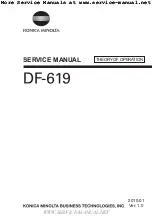
RTfino/RT3200 Advantage–II/RT–x200 SERVICE MANUAL
GE MEDICAL SYSTEMS
P9030GX
THEORY
5–3
REV 0
5–1 INTRODUCTION
RTfino/RT3200 Advantage–II/RT–x200 is a compact ultrasound scanner. It meets the routine needs of both Obstet-
rics and Gynecology investigations. Support of wide range of probes, gives the system added benefits to meet the
diverse applications.
5–2 PRINCIPLES OF ULTRASOUND IMAGING
Ultrasound is produced by applying a short duration, high voltage pulse to the piezoelectric elements in a transducer.
This causes these elements to vibrate at their resonant frequency. (This is determined by the element’s thickness and
tuning.) If the element is making good mechanical contact with the skin, ultrasound waves will be transmitted into the
tissue. (Ultrasound gel applied to the skin prior to ultrasound scanning maximizes transmission).
5–2–1Ultrasound Emission
Ultrasound imaging is based on the sonar principle. A short pulse of sound is transmitted from the transducer’s
piezoelectric crystal element into a medium of known density and propagation velocity, in this case soft tissue.
5–2–2 Reflection
1.
The product of density and velocity is called acoustic impedance. If any change in acoustic impedance is encoun-
tered by the sound pulse, some of the sound will be reflected back to the piezoelectric element in the transducer.
The remaining pulse will continue to greater body depths. The greater the change in acoustic impedance, the
more sound will be reflected.
2.
As the sound travels out and back, an electronic device is used to measure the travel time. Knowing the travel
time (go–return time) and the velocity of the ultrasound wave, the distance traveled can be calculated. Thus,
diagnostic ultrasound images consist of plots of distances between changes in acoustic impedances.
3.
The propagation velocity of an ultrasound wave traveling through different types of body tissues is relatively con-
sistent. An average of 1540 meters per second is used as the standard for normal diagnostic ultrasound applica-
tions. Actually, the percentage of ultrasound wave reflected by soft tissue averages less than 1%. However,
signal reflection increases to 41 to 48 percent when soft tissue–bone interfaces are encountered. Table 5–1 pro-
vides reflection percentages for various types of materials.
TABLE 5–1
REFLECTION PERCENTAGES
MATERIAL TYPE
Fat–Muscle Interface (I/F)
1.08
Fat–Kidney I/F
0.64
Muscle–Blood I/F
0.07
Bone–Fat I/F
48.91
Bone–Muscle I/F
41.23
Soft Tissue–Water I/F
0.23
Soft Tissue–Air I/F
99.90
Reference: McDicken (1976)
PERCENT REFLECTION
















































